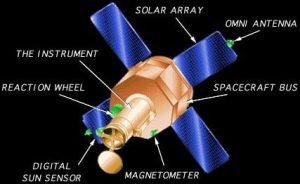What is a Reaction Wheel and How It Works in Satellites
A reaction wheel is a vital component in satellite attitude control systems, allowing spacecraft to maintain or alter their orientation in space. This technology operates by using spinning wheels to create torque, which enables satellites to turn or stabilize without the need for fuel or thrusters. Reaction wheels are critical for tasks requiring high precision, such as Earth observation, communications, and deep-space exploration.

Why Satellites Rely on Reaction Wheels
- High Precision Control
Reaction wheels provide satellites with precise control, crucial for applications like imaging, where accurate positioning ensures high-quality results. This reaction wheel technology allows for fine adjustments, making it ideal for missions requiring steady orientation.
- Fuel Conservation
Unlike thrusters, which consume fuel, reaction wheels operate electrically, conserving the limited fuel supply on board. For long-duration missions, this technology extends satellite lifespan by reducing fuel dependency for orientation.
- Reduced Satellite Mass and Cost
The reaction wheel system is compact and does not require additional propellant systems, which can reduce both the mass and cost of a satellite. Its efficiency also lowers mission costs, making it a preferred choice in modern satellite design.
Key Components of a Reaction Wheel System
A reaction wheel system consists of several critical parts that work together to control the satellite’s orientation. Each component is engineered to function reliably in the harsh conditions of space.
- Electric Motor: Drives the wheel, allowing it to spin at varying speeds and generate the necessary torque.
- Flywheel: The rotating mass that stores angular momentum, creating torque that enables satellite orientation changes.
- Control Electronics: Manages the wheel’s speed and direction to achieve precise control over the satellite’s attitude.
- Mounting Assembly: Secures the reaction wheel to the satellite body, ensuring stability.
How Reaction Wheels Generate Torque
Reaction wheels operate based on the principles of angular momentum. When the wheel spins, it produces an equal and opposite force that the satellite uses to change its orientation. By adjusting the speed and direction of the reaction wheel’s spin, the satellite achieves controlled and accurate movement.
The reaction wheel technology’s design allows for three-axis control, where wheels mounted on each axis enable independent control over the satellite’s roll, pitch, and yaw. This setup makes reaction wheels highly versatile for a wide range of satellite missions.
Challenges and Solutions in Reaction Wheel Technology
Although reaction wheels are widely used, they are not without challenges. The primary issues involve potential mechanical wear over time, vibration, and overheating. Here’s how modern reaction wheel systems address these challenges:
- Improved Bearing Design: Bearings in reaction wheels are designed to withstand high rotational speeds and minimize friction. High-quality bearings reduce wear, extending the wheel’s operational life.
- Vibration Control: Vibration can affect satellite instruments, so reaction wheels are often equipped with damping systems to minimize interference with onboard sensors.
- Thermal Management: High speeds generate heat, so efficient thermal management systems are integrated to dissipate excess heat and maintain wheel performance.
Applications of Reaction Wheel Systems
- Earth Observation Satellites
Reaction wheels are crucial in Earth observation satellites, where stable and precise positioning ensures clear imaging. These wheels allow satellites to maintain orientation toward specific areas for continuous observation or data collection.
- Astronomical Observatories
Space telescopes and observatories rely on reaction wheels for stable pointing accuracy. This technology enables them to focus on distant objects without drifting, ensuring high-quality observations.
- Communication Satellites
For satellites providing communications, maintaining a fixed position toward Earth is essential. Reaction wheels help these satellites maintain their pointing direction, ensuring signal stability and reducing transmission errors.
- Interplanetary Missions
Reaction wheels are used in deep-space missions where fuel efficiency is critical. By conserving fuel, these wheels help spacecraft navigate long distances while maintaining precise orientation for scientific measurements.
Advancements in Reaction Wheel Technology
Innovation continues to enhance reaction wheel technology. Modern systems integrate advanced materials for increased durability and new control algorithms for improved stability and accuracy. Additionally, redundancy in reaction wheel setups allows for continued operation if one wheel malfunctions, further enhancing reliability in space missions.
Future Prospects of Reaction Wheels in Space Exploration
As satellite technology evolves, reaction wheels remain indispensable for attitude control. With ongoing developments, reaction wheels are expected to become even more efficient, lightweight, and durable, supporting complex missions and enabling satellites to operate with greater autonomy and accuracy.
The reaction wheel system remains an essential technology in the aerospace industry, paving the way for cost-effective and sustainable satellite missions. Its role in reducing dependency on fuel and enabling high precision ensures it will continue to be integral to satellite and space mission designs in the future.
